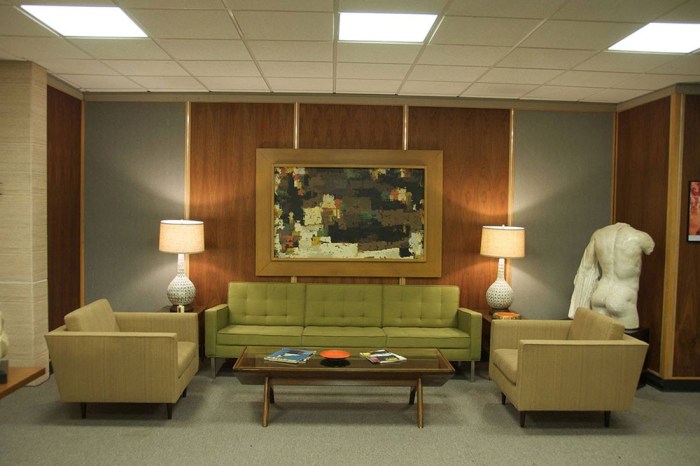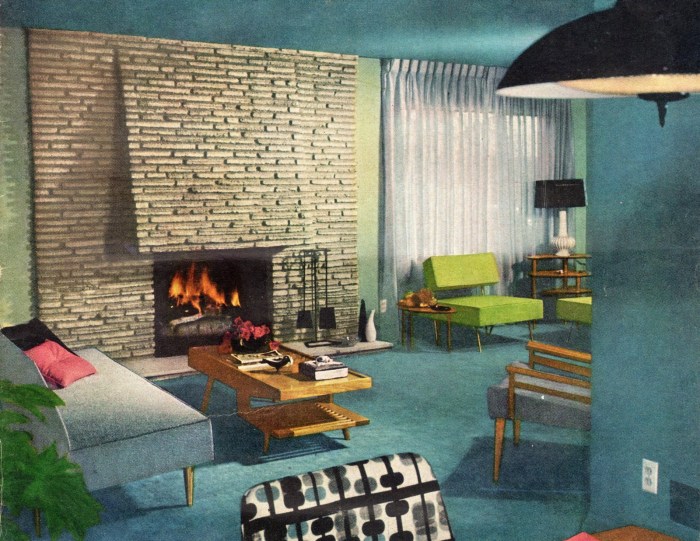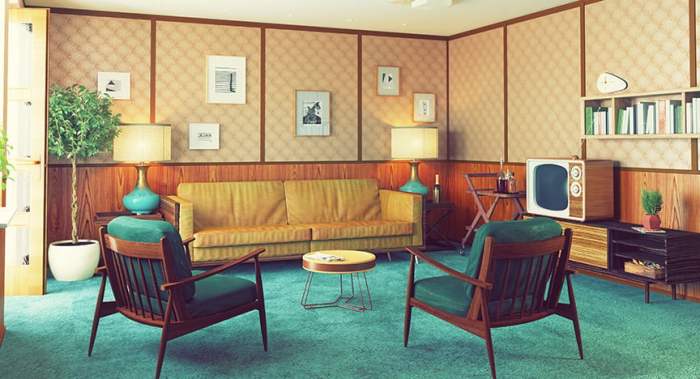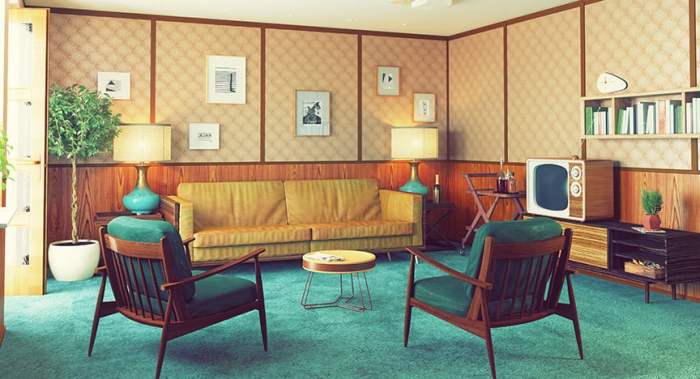60s house interior design was a vibrant explosion of color, geometric patterns, and innovative furniture. It reflected a cultural shift towards individualism, functionality, and a rejection of traditional norms. The era witnessed the rise of youth culture, the Civil Rights Movement, and the Vietnam War, all of which contributed to a desire for change and self-expression.
This design style wasn’t just about aesthetics; it was about creating spaces that resonated with the spirit of the times.
From the bold color palettes and iconic furniture pieces to the integration of new technologies, 60s interiors embodied a unique blend of optimism and experimentation. This period saw the emergence of influential designers like Arne Jacobsen, Eero Saarinen, and Charles and Ray Eames, who redefined the concept of home decor with their functional and stylish designs.
The 60s house became a canvas for expressing personal style and embracing the future.
The Evolution of the 60s House

The 1960s witnessed a dramatic shift in home design, moving from the bold and vibrant aesthetics of the early decade to the sleek and minimalist styles that emerged towards the end. This evolution reflected the changing social and cultural landscape of the time, with a growing interest in simplicity, functionality, and a sense of openness.
The Shift from Mod to Minimalism
The early 1960s were dominated by the “mod” style, characterized by its bold use of color, geometric patterns, and playful textures. This aesthetic, inspired by the British pop culture scene, celebrated youth, optimism, and a sense of liberation. However, as the decade progressed, a counter-cultural movement began to emerge, emphasizing simplicity, functionality, and a return to nature.
The 1960s saw a bold shift in home design, embracing vibrant colors, geometric shapes, and a playful use of materials. While the decade was heavily influenced by the modernist movement, it also looked back to the past, drawing inspiration from the streamlined elegance of 1940 house interior design.
This retro influence manifested in the use of mid-century furniture, wood paneling, and a fondness for vintage accents. The result was a unique blend of modern and traditional elements, creating a distinct and enduring aesthetic.
This shift paved the way for minimalist design, which emphasized clean lines, neutral colors, and a focus on functionality over ornamentation.
Key Design Elements
The transition from mod to minimalist design involved a significant shift in key design elements.
- Color Palettes: Early 60s homes embraced vibrant hues like orange, yellow, and green, often used in bold combinations. As the decade progressed, these vibrant colors gave way to a more subdued palette of neutral tones, such as white, beige, and gray, creating a sense of calm and sophistication.
- Furniture: Mod furniture featured bold shapes, playful textures, and often incorporated bright colors. The minimalist aesthetic favored sleek, streamlined furniture with simple lines and a focus on functionality. Popular examples include the Eames Lounge Chair and Ottoman, designed by Charles and Ray Eames in 1956, which epitomized the minimalist approach to furniture design.
- Patterns and Textures: Mod homes often featured bold geometric patterns and playful textures, such as shag carpets and patterned wallpaper. Minimalist design, on the other hand, favored smooth, clean surfaces and simple patterns, often using natural materials like wood and leather.
- Overall Aesthetics: Mod homes embraced a sense of playfulness and experimentation, often featuring unconventional layouts and a mix of patterns and textures. Minimalist design prioritized simplicity, functionality, and a sense of openness, with clean lines, neutral colors, and a focus on natural light.
Examples of Evolving Trends, 60s house interior design
The evolution from mod to minimalist design can be seen in various aspects of home design, including furniture, color palettes, and overall aesthetics.
- Furniture: The transition from the bold and playful designs of the early 60s, such as the “Panton Chair” by Verner Panton, to the sleek and streamlined designs of the late 60s, like the “Barcelona Chair” by Mies van der Rohe, illustrates the shift towards simplicity and functionality.
- Color Palettes: The iconic “Orange Crate” house by Frank Lloyd Wright, built in 1938, exemplified the bold use of color in mid-century modern architecture. However, by the late 60s, designers began incorporating neutral colors like white, beige, and gray, as seen in the “Farnsworth House” by Mies van der Rohe, designed in 1945, creating a sense of calm and sophistication.
- Overall Aesthetics: The “Case Study Houses” program, which ran from 1945 to 1966, showcased the evolution of mid-century modern architecture. Early Case Study Houses, like the “Case Study House #21” by Richard Neutra, featured open floor plans and large windows, embracing a sense of openness and connection to nature.
Later Case Study Houses, like the “Case Study House #22” by Pierre Koenig, adopted a more minimalist aesthetic, emphasizing clean lines, simple forms, and a focus on functionality.
60s House Interior Design

The 1960s was a decade of radical change, and this spirit of innovation extended to interior design. Beyond the vibrant colors and bold shapes, the 60s saw a shift towards functionality and individuality. These principles, deeply embedded in the design of the era, continue to resonate in modern interiors, proving the lasting impact of the 60s aesthetic.
The Lasting Legacy of 60s Interior Design
The enduring influence of 60s interior design can be seen in the ongoing popularity of mid-century modern aesthetics. This style, characterized by clean lines, organic shapes, and a focus on functionality, has become a cornerstone of contemporary design. The 60s, a pivotal period in the evolution of mid-century modernism, laid the groundwork for its enduring appeal.
The spirit of individuality and functionality, deeply rooted in 60s design, continues to inspire modern interiors. This approach emphasizes creating spaces that reflect personal style while prioritizing practicality and comfort. This focus on individual expression and functionality resonates with modern homeowners seeking to create unique and livable spaces.
Iconic 60s Houses: 60s House Interior Design

The 1960s saw a surge in innovative architectural and interior design, pushing boundaries and challenging conventional norms. This era produced a plethora of iconic homes that continue to inspire contemporary design trends. These houses are not merely structures but testaments to the era’s aesthetic and social values.
Case Study Houses: A Vision of Modern Living
The Case Study Houses program, initiated in 1945 by Arts & Architecture magazine, aimed to showcase innovative and affordable housing solutions for the post-war era. These houses, primarily located in Los Angeles, became a laboratory for experimentation, blending modern architectural principles with the California lifestyle.
“The Case Study Houses were an attempt to develop new ideas for housing in the postwar period. They were intended to be prototypes for affordable, modern homes that could be built quickly and efficiently.”
Arts & Architecture magazine
The program attracted renowned architects like Richard Neutra, Charles and Ray Eames, and Pierre Koenig, each contributing unique interpretations of modern living.
- Case Study House #22 by Richard Neutra (1957): This iconic home, perched on a hillside overlooking the Pacific Ocean, exemplifies Neutra’s philosophy of “organic architecture,” seamlessly integrating the house with its natural surroundings. The use of large glass windows and cantilevered balconies maximizes views and blurs the lines between interior and exterior spaces.
- Case Study House #21 by Pierre Koenig (1960): Koenig’s design, known as the Stahl House, is a masterpiece of minimalist architecture. Its steel frame and glass walls offer panoramic views of the city, while its open floor plan creates a sense of spaciousness and connection to the outdoors.
The Eames House: A Legacy of Form and Function
The Eames House, designed by Charles and Ray Eames in 1949, is a landmark of mid-century modern architecture. Located in Pacific Palisades, California, the house exemplifies the Eames’ philosophy of “design for the real world,” emphasizing functionality, simplicity, and beauty.
“We believe that good design is for everyone, not just for the elite.”
Charles and Ray Eames
The Eames House features a unique combination of materials, including plywood, steel, and glass, showcasing the Eames’ innovative approach to construction. The house’s interior is characterized by clean lines, vibrant colors, and a collection of iconic Eames furniture, including the Eames Lounge Chair and Ottoman, which have become design classics.
- The Eames House’s Interior Design:The Eames House’s interior design reflects the couple’s commitment to functionality and aesthetics. The open floor plan, large windows, and minimalist furniture create a sense of spaciousness and light. The use of vibrant colors, such as the iconic Eames House red, adds a playful touch to the otherwise minimalist space.
- Eames Furniture:Charles and Ray Eames were renowned for their furniture designs, which were characterized by their innovative use of materials and their focus on comfort and functionality. The Eames Lounge Chair and Ottoman, the Eames Molded Plywood Chair, and the Eames Wire Chair are just a few of the iconic pieces that continue to be popular today.
The 60s House: A Reflection of its Time
The 1960s was a decade of immense change and innovation, and the homes built during this period reflected the spirit of the times. The 60s house was more than just a place to live; it was a canvas for experimentation, a symbol of progress, and a reflection of the social and cultural shifts that defined the era.
The Evolving Role of the Home
The 1960s saw a dramatic shift in the role of the home. Traditionally, homes were seen as private spaces for family and domestic life. However, the 60s ushered in a new era of openness and experimentation. The home became a space for entertaining, for expressing individuality, and for embracing the spirit of the times.
- Open Floor Plans:One of the most significant changes in 60s home design was the move towards open floor plans. This shift reflected a desire for more communal living, breaking down traditional barriers between rooms and creating a sense of flow and connectivity.
- Emphasis on Entertaining:The 60s saw a rise in entertaining, and homes were designed to accommodate large gatherings. Features like wet bars, large kitchens, and spacious living areas became popular.
- The Rise of the “Family Room”:The traditional living room, often a formal and reserved space, was replaced by the “family room” – a more casual and comfortable space for family gatherings and relaxation.
Capturing the Spirit of the 60s
The interior design of 60s homes reflected the optimism, change, and innovation that characterized the decade.
- Bold Colors and Patterns:The 60s were a time of vibrant colors and bold patterns. Homes were decorated with bright hues like orange, yellow, and green, often combined with geometric patterns and psychedelic designs.
- Modern Materials:The 60s saw the widespread adoption of new materials, such as plastics, laminates, and acrylics. These materials offered a sense of modernity and were used in furniture, flooring, and décor.
- Mid-Century Modern Furniture:The mid-century modern style, characterized by clean lines, simple forms, and functional design, was a defining feature of 60s homes. Iconic pieces like the Eames Lounge Chair, the Barcelona Chair, and the Saarinen Tulip Table became staples of the era.
Final Conclusion
The legacy of 60s house interior design continues to inspire contemporary styles. Its focus on functionality, bold colors, and geometric patterns remains relevant today, demonstrating the enduring power of this iconic era. Whether you’re incorporating a vintage Eames chair into your living room or adding a touch of psychedelic wallpaper to your kitchen, the spirit of the 60s can bring a unique and vibrant touch to any modern home.
FAQ Overview
What are some common color palettes used in 60s house interior design?
60s interiors often featured bold and contrasting color palettes. Primary colors like red, yellow, and blue were popular, as were jewel tones like emerald green, sapphire blue, and ruby red. Black and white were also frequently used to create a sense of drama and contrast.
How can I incorporate 60s design elements into my modern home?
You can incorporate 60s design elements into your modern home by adding a few key pieces. Consider incorporating a vintage Eames chair, a geometric patterned rug, or a retro pendant lamp. You can also add pops of color with throw pillows, artwork, or even a painted accent wall.
The key is to find a balance between vintage charm and contemporary functionality.
What are some iconic 60s furniture pieces?
Some iconic 60s furniture pieces include the Eames Lounge Chair, the Barcelona Chair by Mies van der Rohe, the Egg Chair by Arne Jacobsen, and the Tulip Chair by Eero Saarinen. These pieces are known for their sleek designs, functionality, and enduring appeal.




